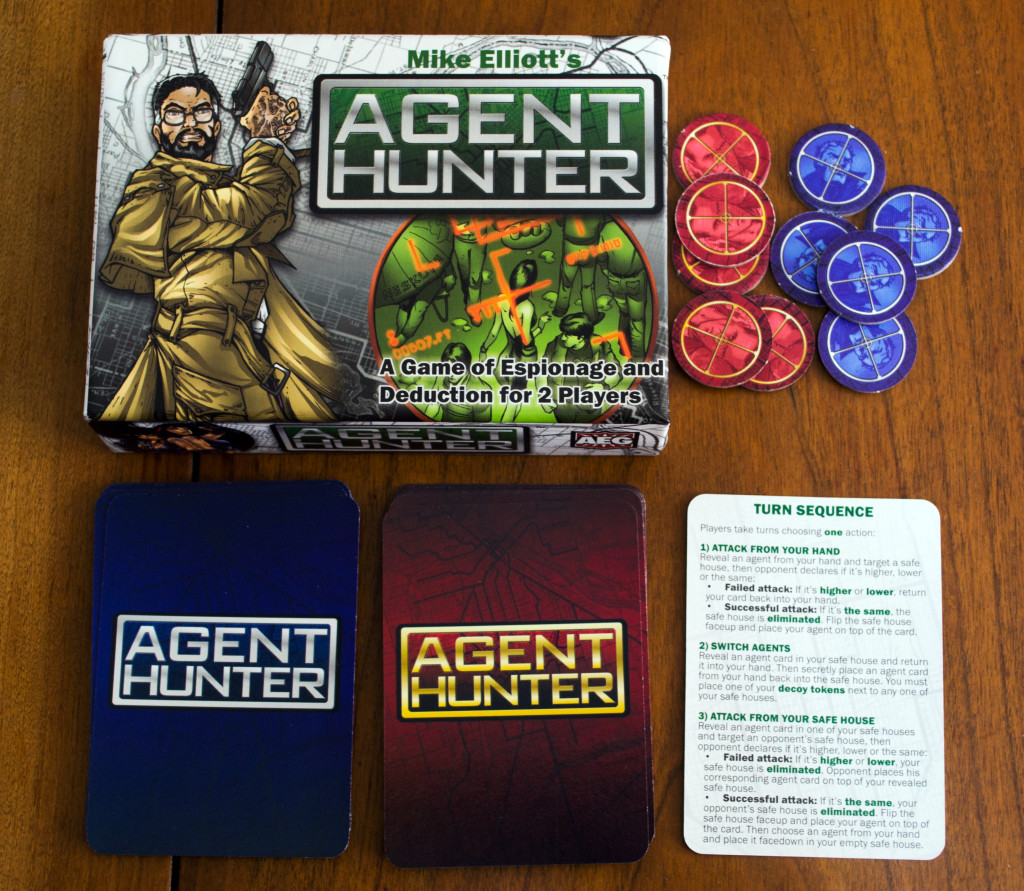I immediately compared this game to “Get Smart” within seconds of finishing the manual, what with agents being the center focus of “Agent Hunter”. This is a two player game where the goal is to eliminate your opponent’s safe houses before he/she does the same to you and secure the most victory points at the game’s end. Que Johnny Rivers and get ready, because you’re about to be a “Secret Agent Man”.
Components
The game includes 20 agent cards, 10 decoy tokens, 2 reference cards, and a rules sheet.
Setup & Gameplay
Each player receives ten agent cards of one color along with five decoy tokens. Players choose three of their cards to be placed face down in front of them, forming their three safe houses. The first player is chosen at random.
On a player’s turn, they’ll take ONE of the following three actions:
1) Attack From Your Hand – Reveal one of your agent cards from your hand, then target one of your opponent’s safe houses. The opponent secretly looks at the agent in the targeted safe house and must declare whether your agent card’s number is “higher”, “lower”, or “the same” as the number on his agent card.
Failed attack: If your agent is higher or lower, return your card back into your hand (the attack has no effect).
Successful attack: If your agent is the same, your opponent’s safe house is eliminated. Your opponent’s agent in the safe house must be revealed face up, then place your agent face up on top of his card. If you eliminate all of your opponent’s safe houses, the game ends.
2) Switch Agents – Reveal the agent card in one of your safe houses to your opponent and return your card back into your hand. Then secretly place one agent card from your hand back into the safe house facedown (yes, this can be the same agent card if you wish). After you place the agent in your safe house, you must place one of your decoy tokens next to any one of your safe houses. Note that players cannot switch agents from eliminated safe houses.
3) Attack From Your Safe House – Reveal an agent card in one of your safe houses and target one of your opponent’s safe houses. The opponent secretly looks at the agent in the targeted safe house and must declare whether your agent card’s number is “higher”, “lower”, or “the same” as the number on his agent card.
Failed attack: If your agent is higher or lower, your safe house is eliminated by your opponent. Your opponent must take his agent card with the same number as your revealed agent, and place it face up on top of your card. If your opponent’s agent is not in his hand, he must reveal the card from his safe house and place it face up on top of your card, then immediately choose one agent from his hand and place it facedown in his empty safe house.
Successful attack: If your agent is the same, your opponent’s safe house is eliminated. Your opponent’s agent in the safe house must be revealed face up, then place your agent face up on top of his card. You must then choose one agent from your hand and place it facedown in your empty safe house.
The game ends when all three of a player’s safe houses have been eliminated. Each safe house that is eliminated is worth one VP to the player that eliminated it. If a safe house is eliminated that has one or more decoy tokens, it is worth additional VPs equal to the number of tokens. Whoever has the most VPs, wins!
Editor’s Note: The above doesn’t cover all of the rules found in the manual, but should give you an idea as to how the game is played.
The Review
For a microgame priced at $6-10 (on Amazon as of 10/20/15), this one is pretty fun. I like games that encourage a little deductive reasoning without being overly complex, and “Agent Hunter” has that. The gameplay is relatively simple, but there’s a lot of memorization required in the sense that you need to keep track of what agents you’ve shown your opponent, which ones you’ve switched out, and likewise, what they’ve been doing.
The card art isn’t bad, though the card stock could have been better. A few of the cards in my game have small white marks on the back, which will no doubt force me to buy card sleeves that are clear on one side and colored on the other. For a game that is all about deducing what card values are, the developers/publishers should really have paid more attention to quality control. In the end, a pretty good value for what you’re getting here…just be careful not to bend or mark any of the card backs.
Final Verdict: 7/10
—

